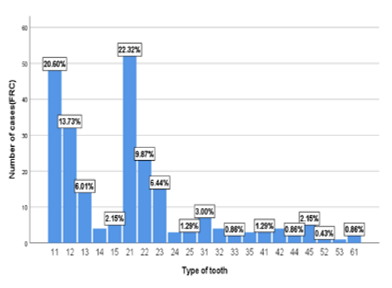Abstract
Bondable fibre reinforced composite posts have gained popularity over the years for reinforcement of endodontically treated teeth. Success rate of these posts has been attributed to their low elastic modulus, resistance to high fatigue, excellent light conductivity etc. This study aimed to evaluate the Fibre-reinforced composite posts among different teeth and to know its association with the number of walls remaining. Data of 233 patients for whom FRC posts were placed at the Department of Conservative Dentistry and Endodontics was obtained from the Dental archives of Saveetha Dental College, Chennai. The type of tooth and number of walls present among age groups and gender were studied retrospectively. The results of the study showed that the use of FRC posts had a male predilection (53.65%) and 31-40 years was the most common age group among patients. A most common tooth was 21 (22.3%), followed by 11 (20.6%) and the least preferred teeth for FRC posts were 52 and 53 (0.4% each). It was observed that tooth type and the number of walls present had no association (p=0.261). Most prevalent number of coronal walls remaining in the tooth that underwent FRC were 2 walls (51.5%). The study draws attention to the fact that use of FRC posts has gained popularity over the years and there is a significant evolution for newer post systems to reduce the failure rate of post endodontic treatment with post and core systems. Since fibre-reinforced systems are incorporated into clinical practice more frequently, there is a need for various clinical studies evaluating the success rate despite the high number of laboratory studies pertaining to the characteristics of fibre posts.
Full text article
Authors

This work is licensed under a Creative Commons Attribution-NonCommercial-NoDerivatives 4.0 International License.

